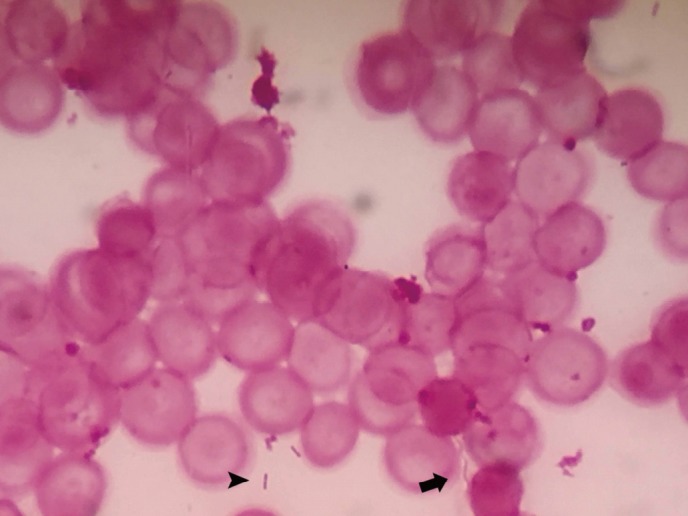Ann Lab Med.
2018 Jan;38(1):71-73. 10.3343/alm.2018.38.1.71.
Polymicrobial Anaerobic Bacteremia Caused by Butyricimonas virosa and Brachyspira pilosicoli in a Patient with Peritonitis following Intestinal Perforation
- Affiliations
-
- 1Center for Infectious Diseases, Nara Medical University, Nara, Japan. hikoichi@naramed-u.ac.jp
- 2Department of Infectious Diseases, Nara City Hospital, Nara, Japan.
- 3Department of Clinical Laboratory, Nara City Hospital, Nara, Japan.
- 4Department of Microbiology and Infectious Diseases, Nara Medical University, Nara, Japan.
- 5Department of Surgery, Nara City Hospital, Nara, Japan.
- KMID: 2397607
- DOI: http://doi.org/10.3343/alm.2018.38.1.71
Abstract
- No abstract available.
Figure
Reference
-
1. Weinstein MP, Reller LB, Murphy JR. Clinical importance of polymicrobial bacteremia. Diagn Microbiol Infect Dis. 1986; 5:185–196. PMID: 3757473.2. Lin JN, Lai CH, Chen YH, Chang LL, Lu PL, Tsai SS, et al. Characteristics and outcomes of polymicrobial bloodstream infections in the emergency department: a matched case-control study. Acad Emerg Med. 2010; 17:1072–1079. PMID: 21040108.3. Lassmann B, Gustafson DR, Wood CM, Rosenblatt JE. Reemergence of anaerobic bacteremia. Clin Infect Dis. 2007; 44:895–900. PMID: 17342637.4. De Keukeleire S, Wybo I, Naessens A, Echahidi F, Van der Beken M, Vandoorslaer K, et al. Anaerobic bacteraemia: a 10-year retrospective epidemiological survey. Anaerobe. 2016; 39:54–59. PMID: 26923749.5. Lee EH, Degener JE, Welling GW, Veloo AC. Evaluation of the Vitek 2 ANC card for identification of clinical isolates of anaerobic bacteria. J Clin Microbiol. 2011; 49:1745–1749. PMID: 21411572.6. Sakamoto M, Takagaki A, Matsumoto K, Kato Y, Goto K, Benno Y. Butyricimonas synergistica gen. nov., sp. nov. and Butyricimonas virosa sp. nov., butyric acid-producing bacteria in the family ‘Porphyromonadaceae’isolated from rat faeces. Int J Syst Evol Microbiol. 2009; 59:1748–1753. PMID: 19542124.7. Prim N, Pericas R, Espanol M, Rivera A, Mirelis B, Coll P. Bloodstream infection due to Brachyspira pilosicoli in a patient with multiorgan failure. J Clin Microbiol. 2011; 49:3697–3699. PMID: 21832021.8. Enemchukwu CU, Ben-Faras H, Gialanella P, Szymczak WA, Nosanchuk JD, Madaline TF. Butyricimonas virosa bacteremia and bowel disease: case report and review. New Microbes New Infect. 2016; 13:34–36. PMID: 27408738.9. Akiyama S, Kikuchi D, Mitani T, Fujii T, Yamada A, Matsui A, et al. A case of mucinous adenocarcinoma in the setting of chronic colitis associated with intestinal spirochetosis and intestinal stricture. Medicine (Baltimore). 2015; 94:e493. PMID: 25634199.10. Sinha R, Ahn J, Sapmson JN, Shi Jianxin, Yu G, Siong X, et al. Fecal microbiota, fecal metabolome, and colorectal cancer interrelations. PLos One. 2016; 11:e0152126. PMID: 27015276.
- Full Text Links
- Actions
-
Cited
- CITED
-
- Close
- Share
- Similar articles
-
- The 23S rRNA gene PCR-RFLP used for characterization of porcine intestinal spirochete isolates
- Three cases of meconium peritonitis
- A Case of Spontaneous Bacterial Peritonitis with Bacteremia Caused by Shewanella algae
- Ileal Atresia Complicated by Meconium Peritonitis
- Septic Arthritis Caused by Bacteroides thetaiotaomicron Bacteremia in a Patient with Multiple Myeloma


